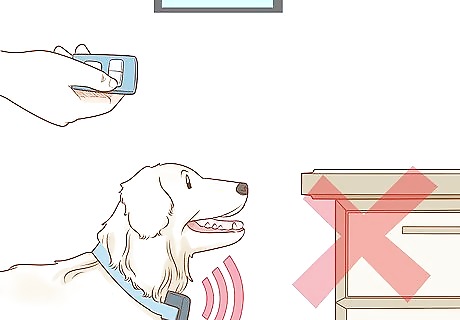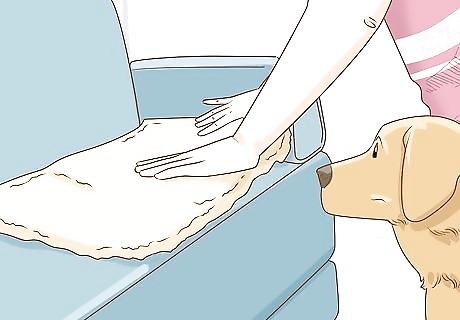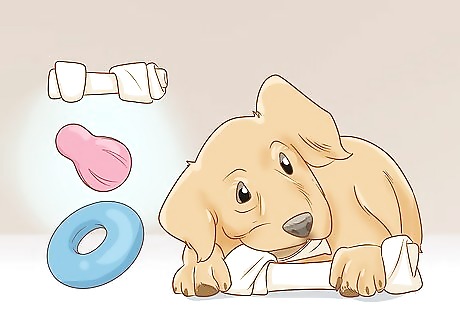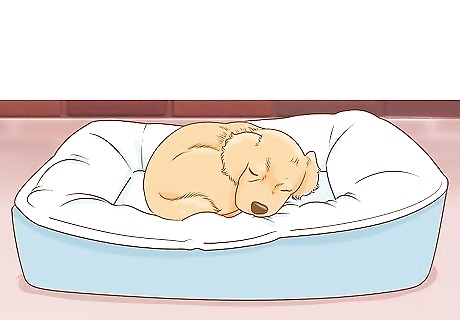
views
X
Expert Source
Indigo WillProfessional Canine Expert
Expert Interview. 8 September 2020.
Sometimes dogs will chew furniture as a way to exert their energy if they are not receiving enough exercise. They may also destroy furniture if their current chew toys and bones no longer interest them. To protect furniture from your dog while you are away from home, there are prevention methods you can practice to keep your dog satisfied, happy, and preoccupied.
Keeping Your Dog Away From Your Furniture

Apply unpleasant flavors to furniture your dog has chewed on. If your dog is attracted to a specific piece of furniture and it just won't leave it alone, you may need to make that piece of furniture unpleasant to the dog. Putting an unpleasant taste on it may just do the trick and it may prevent your dog from continuing to chew on your furniture in the future. Use foods or seasonings that will not be toxic to your dog, such as hot sauce or cayenne pepper. If you don't want to use spices to keep your dog off your furniture, you can purchase a commercial, furniture-safe, anti-chewing spray from a retail store that specializes in pet products.

Place unpleasant textures on the furniture. If you don't want to put unpleasant tastes on your furniture, then try using unpleasant textures. For example, you can put aluminum foil or double-sided tape on areas that your dog is attracted to. The crinkles of the foil and the stickiness of the tape will both be unappealing to your dog.

Use a remote deterrent to make the furniture less appealing to the dog. Choose a deterrent that your dog dislikes and that will activate when the dog approaches the furniture. For example, a motion activated can of compressed air posted near the furniture could make the dog avoid the area. Don't choose anything that will emotionally scar the dog, such as a deterrent that frightens the dog. If the dog will not even enter the room at all, then you should remove the deterrent.

Confine your dog to an area without furniture. Place your dog in an enclosed yard with a fence or a dog run when you are not home. If your dog is crate trained, put it in its crate. This will allow your dog to roam freely without damaging any valuable items or furniture. You can also place your dog and its toys in a room without furniture to prevent it from causing any damage. If you place your dog outside while you are not home, make sure that it has shelter from extreme temperatures and weather, and water and food available to it at all times.

Block access to furniture. If your dog has a particular piece of furniture that it likes to get on when you are away, then you may want to block access to it. For instance, if the piece of furniture is a chair, place something large in the chair before you leave, so that the dog cannot get in the chair. Taking a little bit of time before you leave your home to limit your dog's temptations will be beneficial to both you and your dog. Try placing baby gates around your furniture to keep your dog away.

Cover furniture with rugs, blankets, and washable covers. This will protect your furniture from fur or urine. It's normal for dogs to shed fur, which will end up on your furniture if the dog does get on it. Covering furniture with items you can wash, such as rugs, blankets, or covers, makes it easy to keep the furniture clean. Whenever the washable item gets dirty, simply throw it into a washing machine. If you're worried about the look of your living room, chose a stylish throw that's still washable. You can easily incorporate this into your decor. You can also find special blankets made to protect furniture from pet fur, urine, and feces. If your dog frequently has accidents on the couch, rugs can be a better option than other fabrics. Alternatively, you could put puppy pads or plastic covers under the blanket.
Reducing the Likelihood of Doggy Damage

Dry off your dog after walks, especially if it rained. Dogs can get wet paws during a walk, or could even come home muddy. As soon as your pet re-enters the house, be sure to dry him off, especially his feet. This will prevent the pup from jumping on furniture, which could leave marks. Use a towel to clean the dog's feet and fur.

Housebreak your dog. If your dog has accidents on the furniture, it likely needs to go through housebreaking again. Once your dog gets used to a walking schedule, it should not have accidents in the home unless there is a medical issue. If the dog is old and experiencing accident due to age, do not try to housebreak it. Some older dogs cannot control their bladders.

Get a the dog fixed if it's marking furniture. Hormones can cause both male and female dogs to mark your furniture by peeing on them. This is because dogs are territorial. Getting the dog spayed or neutered can reduce this behavior and protect your furniture.
Training Your Dog to Stay Away From Your Furniture

Train your dog early to stay away from your furniture. From the time your dog is young, you should make it clear that your furniture is off limits. If you have done thorough training with your dog throughout its life, this boundary will be clear and your dog will stay out of areas that you don't want it to be in. This type of training can take a long time. Be patient and understand that you need to be clear and consistent with your dog in order for it to understand what you want it to do and not do.

Correct your dog's behavior. When you catch your dog on your furniture you need to make it clear that that behavior is not allowed. This will help your dog understand that they are misbehaving. Say "No" in a firm manner to your dog at the same moment you see them jumping onto or chewing your furniture. This will convey to them that their behavior needs to stop immediately.

Redirect your dog's attention. Provide your dog with one of their toys immediately after scolding them for chewing on your furniture. Then praise them when they begin playing with or chewing the toy. This will help your dog understand which behavior you find more acceptable.
Preventing Damage with Exercise and Stimulation

Exercise your dog on a daily basis. Exercise will stimulate your dog mentally and physically. This will allow your dog to burn energy that may otherwise be directed toward chewing or damaging your furniture. The amount of exercise your dog should receive will vary on its breed and size. Most dogs will require between 30 and 60 minutes of continuous exercise daily. This can include walking, playing fetch, running, or tug-of-war. Consult with your dog's veterinarian to find out exactly how much daily exercise your dog should receive based on their size and breed. If you are unable to exercise your dog on a daily basis, hire a dog-walker or pet-sitter that can perform this task for you.

Provide your dog with stimulating toys. Your dog should have a variety of toys to keep it entertained and to keep its attention away from your furniture. For example, you can buy toys specifically designed for hiding dog treats inside of them. These toys can be used as a distraction for your dog if you ever see it starting to chew on your furniture. You can also purchase toys to help keep your dog active, such as tennis balls it can chase and rope toys it can swing or toss around. There are also a variety of toys and bones made of materials that are difficult to chew, like nylon, that might be appealing to your dog. Purchase specific toys that may comfort your dog if it is feeling lonely while you are away from home. Examples of comfort toys are soft, stuffed, and plush toys. You could also use items that carry your scent that you don't mind your dog having, such as an old, unwashed t-shirt you no longer want.

Make your dog feel less alone. If your dog has anxiety when left alone, try leaving your radio or television on while you are away from home. This can help your dog feel more comfortable with being alone. Be sure to turn on programs that do not have aggressiveness or loud noises. Typically, easy-listening music or shows that feature people talking are best.

Give your dog a place to lie comfortably. If your dog is constantly getting up on your couch or chairs, it may need another comfortable spot to lie down before it will keep off the couch. If you provide it with a plush bed that is super soft to lie on, the dog will likely choose that over a piece of furniture it gets scolded for being on. This is especially important for older dogs. They will benefit immensely from a soft place to lie if they are experiencing the aches and pains associated with aging.




















Comments
0 comment